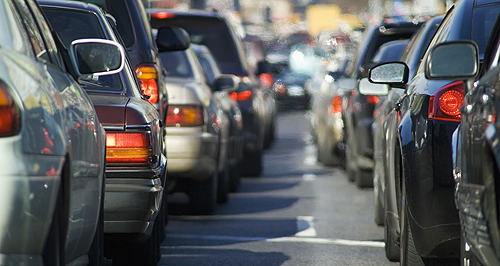News - General News - EmissionsAustralian average CO2 reduction continues to stallAltered carbon: The average CO2 emissions of new vehicles purchased in Australia last year fell from 182.1 grams per kilometre to 181.7g/km. SUV popularity continues to slow reduction of average CO2 emissions in Australia12 Jun 2018 UPDATED: 13/06/2018
THE National Transport Commission (NTC) has released its Carbon Emissions Intensity for New Australian Light Vehicles report for 2017, finding that the reduction of average carbon dioxide (CO2) emissions from new vehicles – excluding heavy commercial – purchased in Australia during a calendar year has continued to stall.
Specifically, a 0.3 per cent reduction was accomplished between 2016 and 2017 – the first year SUVs outsold less pollutant passenger cars locally – with average CO2 emissions falling from 182.1 grams per kilometre to 181.7g/km.
This represents the smallest improvement since such data started being recorded in 2002, with a 28 per cent overall reduction achieved during the 16-year period.
Light vehicles (passenger cars and SUVs) accounted for 171.5g/km, down 0.7 per cent, while light-commercial vehicles were responsible for 221.2g/km, down 0.4 per cent.
Comparatively, average CO2 emissions for light vehicles were 118.5g/km in the European Union last year, up 0.3 per cent, making Australia’s result 45 per cent higher.
According to NTC chief executive Paul Retter, shifting Australian buyer preferences are partly to blame for the increase in average CO2 emissions.
“Australians continue to show a preference for SUVs and utes in the 1.15 million light vehicles sold last year, which have higher emissions than smaller or greener alternatives,” he said.
“If all Australians who purchased a new vehicle in Australia had purchased ones with best-in-class emissions, the national average carbon emissions intensity would have been reduced by 58 per cent, to 76g/km.”
Federal Chamber of Automotive Industry (FCAI) chief executive Tony Weber echoed this sentiment, adding that buyer preferences should be a key consideration in the discussion around Australian CO2 standards alongside the need for higher-quality fuels and wider powertrain options.
“The only issues standing between Australia having a better CO2 outcome is fuel quality, of which we have some of lowest quality in the OECD, and consumer choice,” he said. “We at the FCAI think that maintaining consumer choice is important.”
As previously reported, the Australian federal government is still debating the regulation of CO2 emissions, with a mandatory target of 105g/km by 2022 proposed by the Australian Greens in March this year.
Predictably, the micro-car segment was the least pollutant last year, at 126g/km (down 0.6 per cent), while the upper-large-SUV segment had the highest CO2 emissions, at 261g/km (down 1.7 per cent). Overall, SUVs were down two per cent, from 185g/km to 182g/km.
Similarly, electric vehicles (49g/km, up 1.8 per cent) led the charge ahead of their petrol (170g/km, down 0.9 per cent), diesel (206g/km, up 0.5 per cent) and LPG (225g/km, up 1.7 per cent) counterparts.
Interestingly, the NTC has provided sales estimates for Tesla, who does not subscribe to FCAI data used for the report, using state- and territory-based registration systems.
According to NTC, the American marque sold about 1300 examples to end of 2017, representing a 116.7 per cent increase over the about 600 deliveries it made during the same period in 2016. About 2783 vehicles have been moved since Tesla’s local inception.
Overall, about 2424 EVs found homes last year – a 77 per cent increase over the 1369 units sold in 2016. This total comes from the 24 EV variants available on the market in 2017.
More broadly, ‘green’ vehicles – defined as those with CO2 emissions of 120g/km or less – accounted for 3.8 per cent of total sales in 2017, up 2.5 per cent in 2016. This rise was thanks to the 97 ‘green’ vehicles available locally last year – 42 more than the 12 months prior.
While 51 brands were available to new-vehicle buyers overall in 2017, 15 accounted for 92 per cent of total sales, with Audi leading the way, at 145g/km (up 1.1 per cent), while Holden finished last, at 219g/km (down 1.4 per cent).
Given Holden and Toyota finished their Australia car manufacturing operations in October last year, 2017 will be the last year that the NTC includes data on locally made vehicles in its report.
Last year saw home-grown vehicles produce 219g/km, up 2.9 per cent, with Toyota (175g/km, down 0.2 per cent) pacing Ford (229g/km, down 2.0 per cent) and Holden (259g/km, up 11.1 per cent).
Private buyers (176g/km, up 0.1 per cent) purchased the least pollutant vehicles in 2017, followed by business (186g/km, down 0.6 per cent) and government (199g/km, down 1.1 per cent) buyers.  Read more5th of June 2017  Aussie consumer trends slowing CO2 reductionNew cars getting cleaner but not a focus for Australian consumers, says report2nd of April 2016  Rate of new-car emissions decline stallsTailpipe emissions in Australia on downward trend but 4g/km drop no better than 20142nd of April 2016  Market Insight: Mixed CO2 results for top brandsNissan improves most, but still at back of field, in latest NTC CO2 report card12th of February 2016  Cautious welcome for emissions discussion paperThorough consultation needed for smooth vehicle emissions transition: AAA, FCAI24th of April 2015  Market Insight: The great green car dilemmaGulf between greenest cars, top sellers widens with new tech vs traditional values20th of April 2015  Market Insight: New-car emissions down but rate slowsTailpipe emissions in Australia fall, but 2.3 per cent drop the slowest since 2009 |
Click to shareGeneral News articlesResearch General News Motor industry news |



















Facebook Twitter Instagram